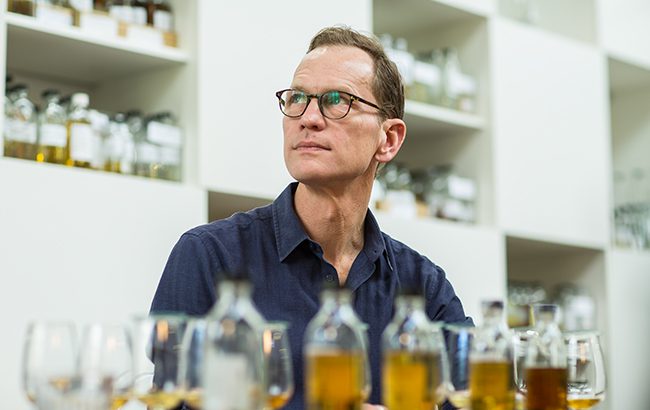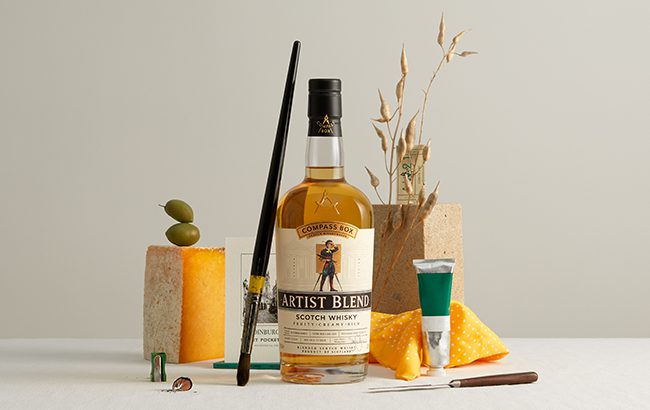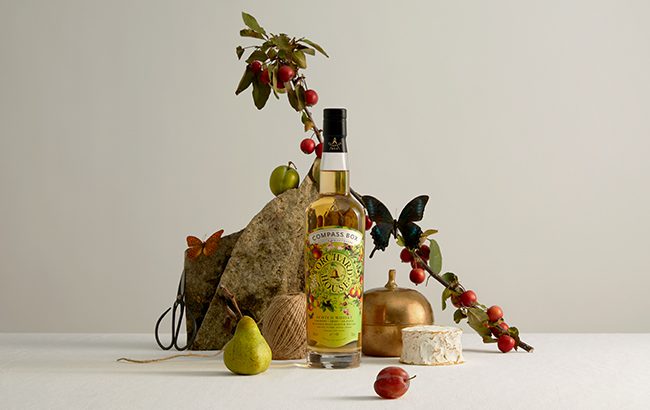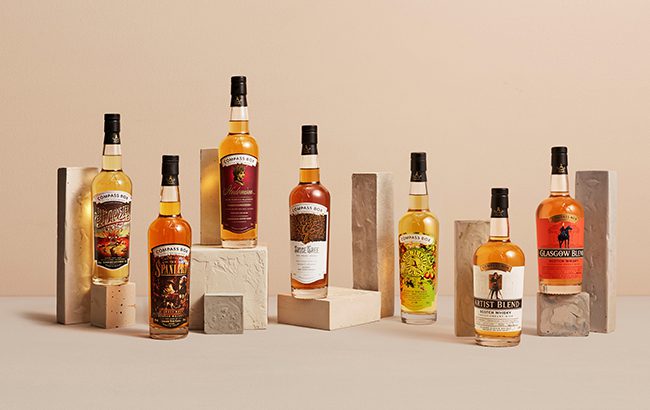This website uses cookies so that we can provide you with the best user experience possible. Cookie information is stored in your browser and performs functions such as recognising you when you return to our website and helping our team to understand which sections of the website you find most interesting and useful.
Big interview: John Glaser, Compass Box
By Melita KielyScotch whisky brand Compass Box has always done things its own way, thanks to the ingenuity of its founder, John Glaser. As the company moves to the next stage in its development, SB meets the man with a vision.

*This feature was originally published in the June 2022 issue of The Spirits Business
When the US imposed punitive tariffs on Scotch whisky in 2019, the government specifically targeted single malts – not blends of any sort. For a company dedicated to blended whisky, such as Compass Box, it mercifully granted a ‘free pass’ from a tax that grossly affected exports in 2020. The decision to clamp down on single malts is demonstrative of the subcategory’s perception compared with its blended counterpart, notes Compass Box founder and whisky maker John Glaser.
“The administration that put these tariffs in place thought, ‘well, single malts are the best; they must be the most expensive’, not thinking that there may be blended Scotch whiskies and blended malts, and other categories of Scotch whisky, which are equally good, equally expensive, or more expensive,” says Glaser. “People have this perception that single malts are the best.”
But Glaser sees the beauty in blends. Since he launched Compass Box in 2000, his goal has been to showcase all that is great about the blended Scotch whisky category.
From wine to whisky
After university, Glaser was determined to become a wine maker in his US homeland – a desire that greatly influences his approach to whisky‐making today. But a wise word of advice from “a great friend and mentor of mine, Peter Holt” saw Glaser step out of the “long line of people trying to become wine makers in California” and into business school. From there, he secured a job in marketing with the world’s biggest blended Scotch whisky brand, Johnnie Walker.
The self‐confessed “wine geek and beer home brewer” was not a Scotch whisky drinker at the time – but after being sent to Scotland, Glaser was soon enamoured with the ‘water of life’.
Glaser reflects fondly on working with “legends in the industry”, including recently retired Johnnie Walker master blender Dr Jim Beveridge, and Diageo master blender Maureen Robinson. “Blending really did capture my imagination as a creative platform,” Glaser explains.
“Over the course of various projects I was involved in, I was asking lots of questions about why do we do this, and why do we always use that, why do we re‐use refill casks so much? Why hogsheads and barrels? Why do we chill filter? Why do we colour whiskies with this caramel stuff? And so on and so forth.”
Then, during a holiday to the Bahamas with his wife, Glaser had his ‘eureka!’ moment, and realised his ambition to set up his own Scotch whisky company.
“This was around 2000; whisky was in the doldrums – the whole industry was in the doldrums,” he recalls. “Global sales were flat or declining, depending on the year back then. Most of the big whisky companies had way too much ageing inventory in their warehouses. But I thought, there’s something here with Scotch whisky that the average person under the age of, say, 40 has no idea about.
“There’s something really extraordinary and compelling, and magical, a deep cultural history that nobody gets, nobody understands. I thought I could bring this discovery to the world by doing it on my own rather than with all the money we had at Johnnie Walker.”

Compass Box’s first release was Hedonism, which is still available today. Interestingly, Glaser chose to begin with a 100% grain whisky. “Certainly, back then, grain whiskies bottled on their own were very few and far between, and there were zero major brands of grain whisky at the time,” he recalls.
The goal was to help Compass Box stand out from the Scotch whisky market – not just with the liquid. Glaser was keen to move away from what he describes as “labels that look like they were designed in the time of Queen Victoria”, and show how things can be done differently, but done well.
Mixed reactions
Reactions from the trade were mixed, to say the least. Glaser flew to the US to showcase Hedonism in New York and at the San Francisco whisky festival, before taking on London with “bottles of Hedonism in my rucksack, walking from bar to bar and from store to store”, and then heading up to Scotland. Reactions, safe to say, were mixed.
England, he says, was slower to warm to Glaser’s disruptive approach. “I got more of, ‘is this some marketing gimmick? What’s going on with this label that has a picture of a woman’s head with all this stuff coming out of it? What’s going on?’” he recalls. Meanwhile, in Scotland, producers were more willing to see if Glaser’s approach could be just what they needed to pull them out of the “doldrums”.
“In Scotland, a lot of people said, ‘hey, you know what, our national drink is not doing very well. We’ll take anybody, even an American who’s trying to create something different with a sincere, unique approach to Scotch whisky, and integrity in terms of quality,” Glaser notes.
Glaser sees wine as more transparent than Scotch, and he has been a crusader for greater transparency in whisky. At times, his devotion to the matter has landed him in hot water. For the first 15 years of Compass Box, he says, each bottle carried the name of the distillery where the liquid was sourced, plus percentages of each component of the blend, and more. That was until Glaser was reported to the Scotch Whisky Association (SWA).
“To the credit of the Scotch Whisky Association, they had to do their job and tell us we couldn’t do that, and that’s when we started the campaign,” Glaser explains, referring to the 2016 Scotch Whisky Transparency petition. The goal was to persuade the industry to change the rules and allow producers to list more than the youngest liquid in the bottle on the label.
Changing the rules required agreement between all 27 member states of the European Union. “And then Brexit hit, and they all got even less interested in changes,” Glaser says. However, he remains resolute that greater transparency is imperative to the category’s future success.
“It is an idea that absolutely still has merit because age is not everything; older is not necessarily better, it’s just different,” Glaser insists. “It gives more interested drinkers an idea of what to expect.”
Glaser does, however, see “a lot more openness now” when it comes to transparency, particularly with smaller or independent producers.
“There’s more that we as an industry need to do,” he adds. “The outdated legislation, which prohibits people from talking about the age of anything other than the youngest whisky in a bottle, needs to change. There’s just no logic there, no rationale for keeping it. It’s just inertia on behalf of the industry. Unless, of course, there are companies in the industry who feel that the law protects them from having to disclose everything they have.”

However, he isn’t convinced by the recent updates to the regulations allowing for a broader variety of casks to be used to mature Scotch whisky.
“Now we’re talking about the ability to change Scotch whisky legislation when the powers that be behind the Scotch Whisky Association want to change,” he says. “It hasn’t made any difference to us. It’s just not my thing, Tequila casks with Scotch whisky in them, I don’t get it; I don’t get the deliciousness or how they match.”
In each of his bottlings Glaser looks for a whisky that is “compelling”. Recent launches include August 2021’s Compass Box Orchard House, described as a fruit‐forward malt whisky, and a first for the company. Liquid was sourced from a number of distilleries known for their fruity flavour profiles, before being aged in a mix of Compass Box casks, including water‐rinsed, first‐fill ex‐Bourbon barrels, oloroso Sherry‐seasoned butts, and French oak custom barrels.
Blurring the boundaries
This year, Compass Box Experimental Grain Whisky came to market with the aim of blurring the boundaries of the Scotch category. Containing a portion of spirit made from peated malted barley, the 100% malt whisky differs from others because it was distilled in a column still, rather than a pot still. As such, it must legally be defined as a grain whisky in accordance with Scotch regulations.
“It’s all about making whisky that calls you back after you’ve had a sip or two,” Glaser continues. “And you can have compelling whiskies that are five years old or 25.”
April 2022 brought major developments for Compass Box, when former Bacardi executive Maurice Doyle was named as the company’s CEO. Doyle boasts almost 30 years’ experience in marketing and commercial leadership in the global premium drinks industry. His appointment will allow Glaser to focus more on areas where “I think I bring the most to the party”, which is whisky making.
The news coincided with the announcement that London investment firm Caelum Capital had become majority shareholder of Compass Box. The acquisition, financial details of which were not disclosed, will help fund the firm’s desire to seek out compelling whiskies, experiment and innovate.
“Unless a person who starts a business is independently wealthy, or fabulously wealthy, you need people to invest in your business. That’s what Caelum Capital represents for us. We have a very small megaphone, if you will, and have had for 22 years.
“I didn’t start this business to make myself a lot of money. I started this business because I love Scotch whisky, and I see a way of bringing Scotch whisky to the world that most other people don’t see. Caelum Capital will give us the foundation to focus on what we’re really good at,” Glaser explains.

For Glaser, Scotch whisky faces two key challenges. The first is the category’s marketing past, which Glaser describes as the industry’s attempt to make Scotch “this aspirational drink of successful men that goes back decades”.
The second issue is the category’s pricing past, “particularly in markets like here in the UK”, he notes. Glaser explains how “heavy discounting” began in the 1980s, when Scotch whisky sales and global shipments to established markets started to fall.
“Producers tried to make up for falling sales by discounting in order to maintain the volumes,” he says. “Small gin brands are more expensive than most of the whiskies on the shelf. It might take 10 years to make ‘whisky X’ that’s on sale from £27 to £20, and it takes a day or so to make this gin, which is selling for £37 right next to it. There’s something wrong there.”
Nevertheless, Glaser is not too fretful about this particular end of the market, as he is certain those who buy Compass Box products see the value in the whiskies, and the packaging designs.
“We put the names and stories and the information we provide around our bottles,” he says. “Every single Compass Box product is sort of one big poetic biosphere. I don’t worry about the Scotch whisky industry or how the category is doing because, you know, 80% of it is cheap brands that we don’t care to compete with. They’re in a different category, as far as I’m concerned.”
In 2021 Compass Box enjoyed its “best year ever in 22 years”, Glaser adds excitedly, made even sweeter by the “precarious position” the business found itself in when the Covid‐19 pandemic struck in 2020.
Looking to the next 22 years, Glaser has a simple, albeit global, ambition. “In a folder are all the things that are important to me in my life,” he reveals.
“Every morning, if I’m not travelling, I look at this piece of paper and one of things on this paper is that in time, Compass Box is regarded by most whisky lovers around the world as one of the admired brands, a brand that inspires them. That’s what’s important to me, and that’s what we’re trying to build for the future.”

